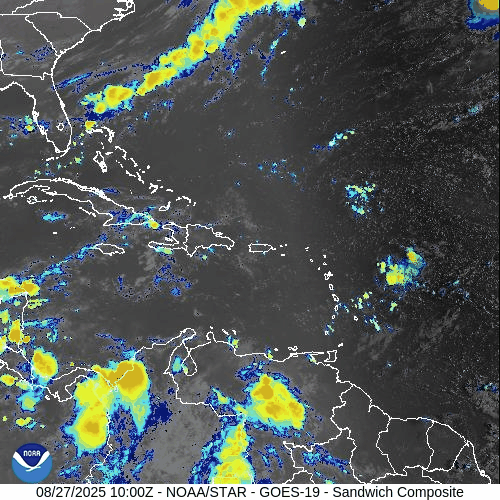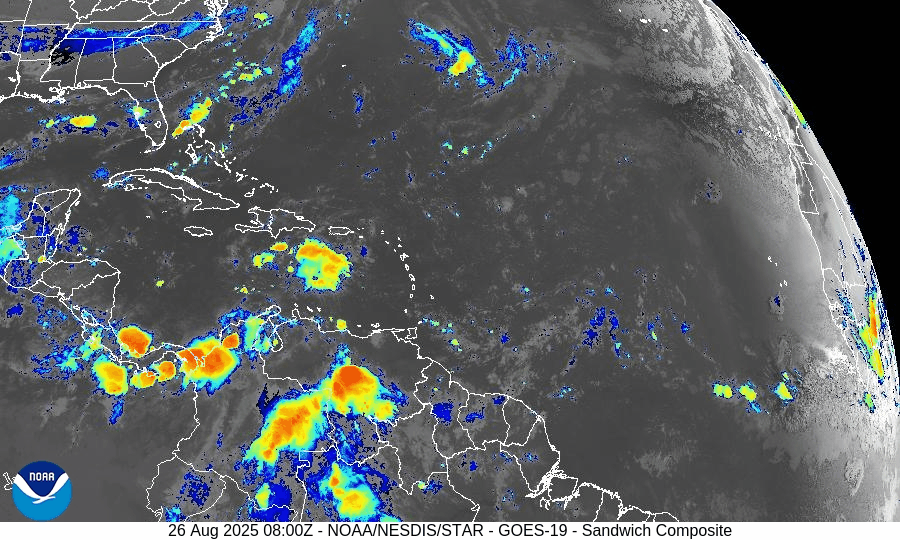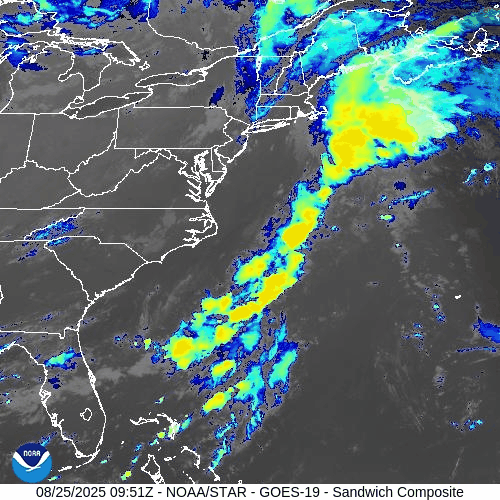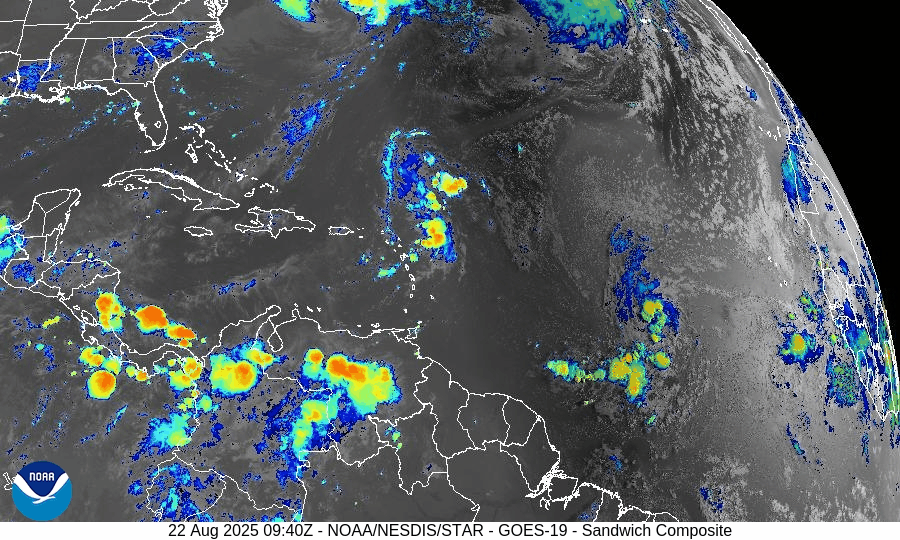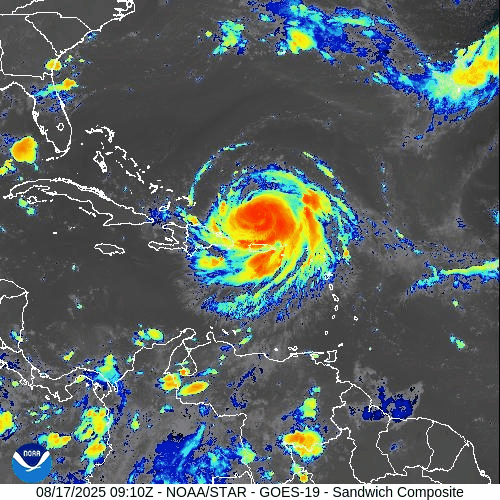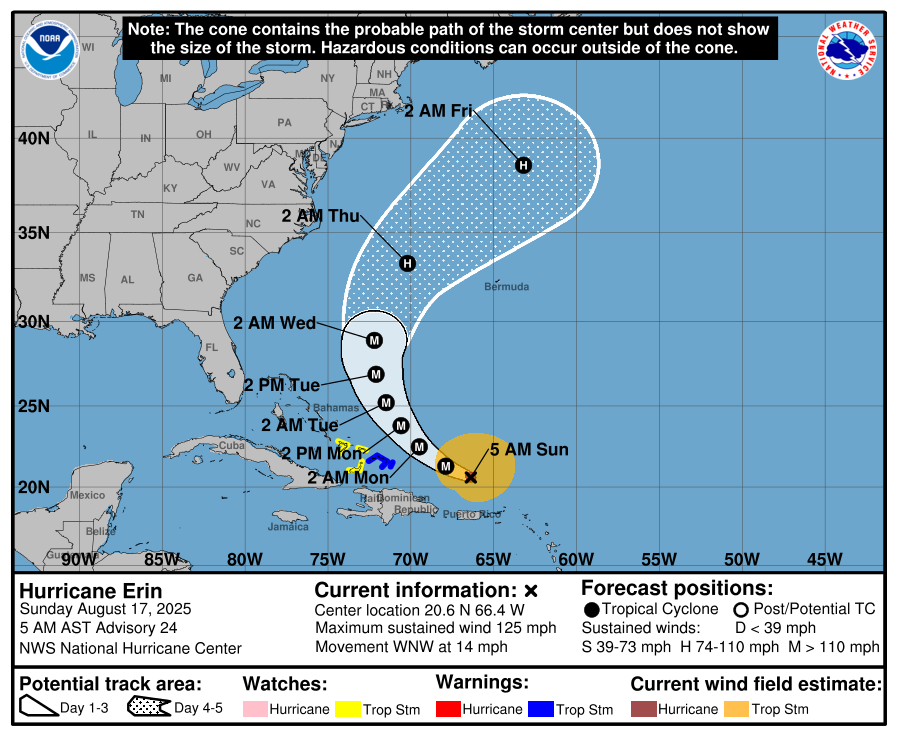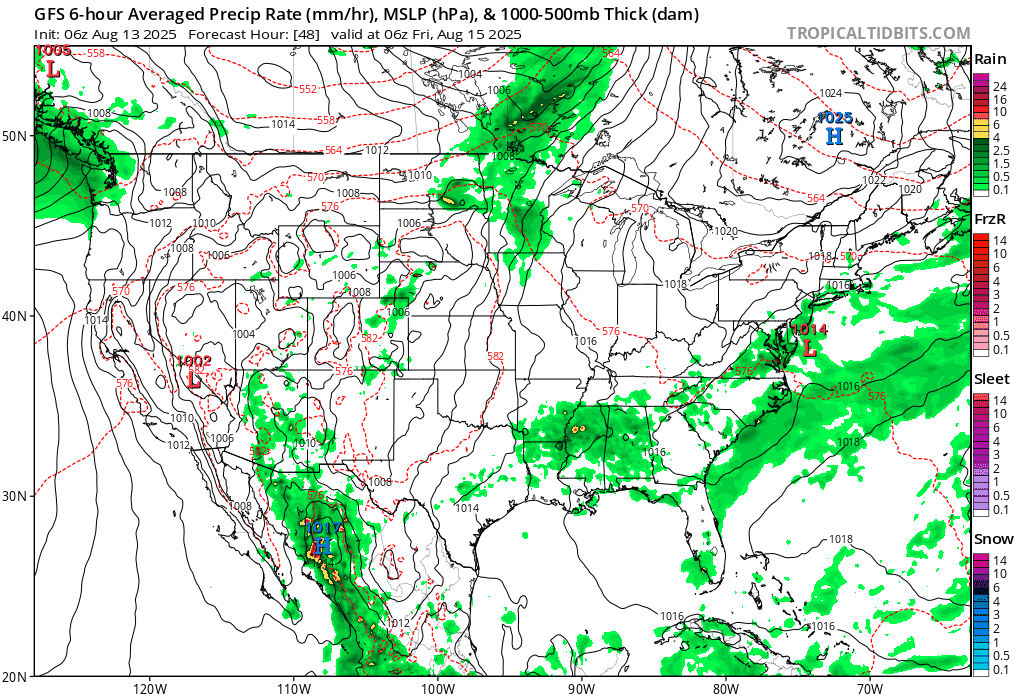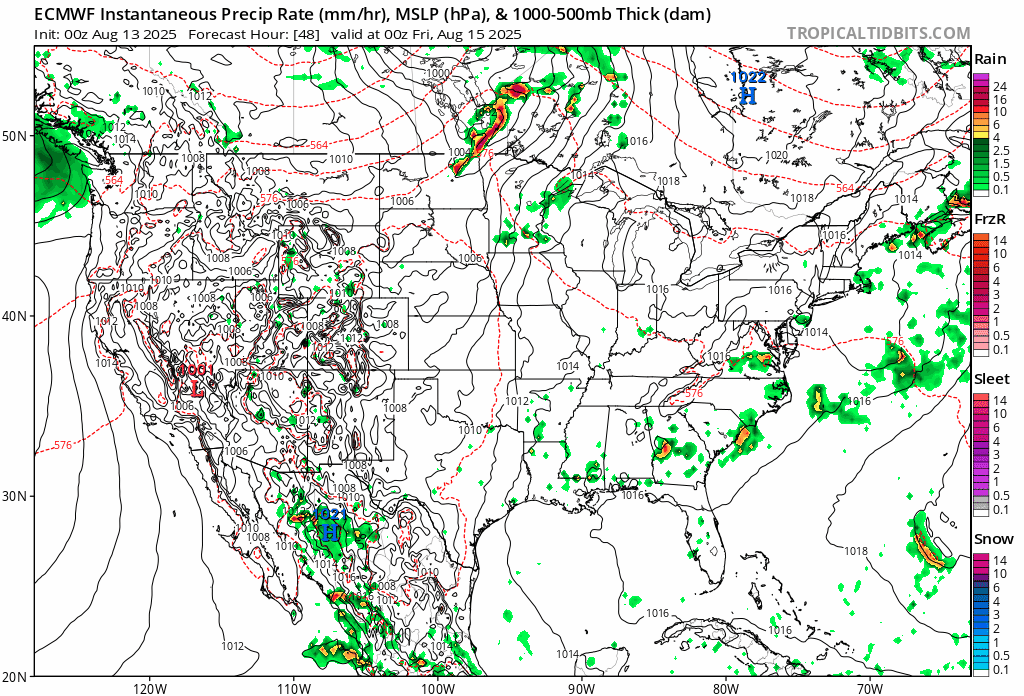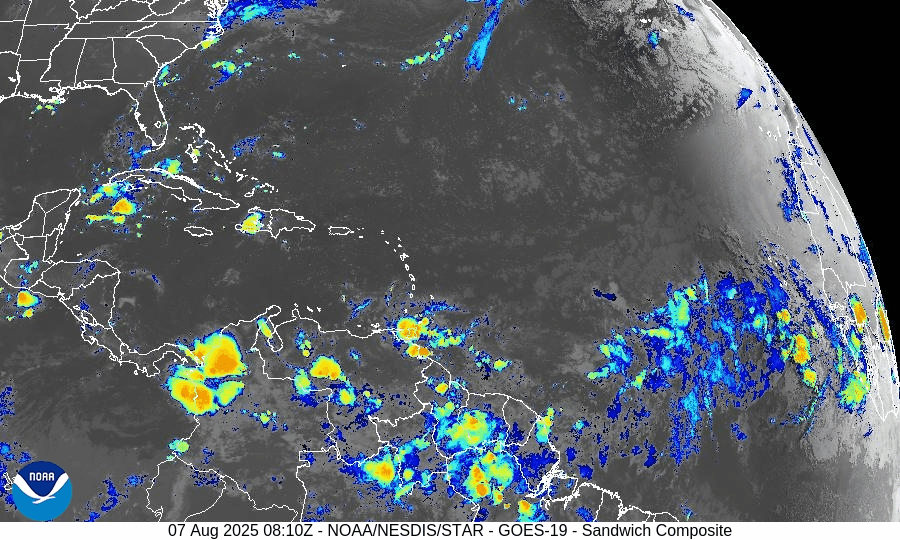Atlantic Hurricane Outlook – August 27, 2025
On August 27, Tropical Storm Fernand transitioned into a post-tropical system southeast of Newfoundland. While Fernand poses no threat to land, Erin’s long-period swells continue to drive dangerous surf and rip currents from the Carolinas through New England. Florida and the Gulf of Mexico remain calm, with only typical late-August thunderstorms and no signs of tropical development.
TLDR Version: Click Here
Tropical Storm Fernand becomes post-tropical over open waters; East Coast surf threats persist
Atlantic Basin Overview
Tropical Storm Fernand
As of 5 AM AST (0900 UTC), Fernand is situated near 38.3° N, 50.8° W, approximately 590 miles southeast of Cape Race, Newfoundland. The system carries sustained winds of 45 mph, is moving east at 12 mph, and maintains a central pressure of 1007 mb.
No coastal watches or warnings are active. Fernand is expected to transition into a post‑tropical system later today, then evolve into a trough and dissipate by Thursday.
Hurricane Erin’s Lingering Surf Impacts
Despite being long gone, Erin's energy continues to affect coastal waters. East Coast beaches—from the Carolinas through New England—continue to experience rough surf and dangerous rip currents.
No Other Tropical Activity
There are no new tropical disturbances of concern at this time, and forecast models show an inactive Atlantic basin in the short term.
Environmental Conditions
Sea Surface Temperatures (SSTs): Waters remain warm in the subtropics but are cooling northward—supporting Fernand's decay.
Wind Shear: Moderate winds aloft are increasing and will help dissipate Fernand.
Mid-Level Humidity & SAL: Dry air and dust from the Saharan Air Layer still suppress convection across the Atlantic, limiting new storm formation.
Gulf of Mexico & Caribbean
The Gulf remains quiet and stable, dominated by high pressure. Afternoon thunderstorms continue in coastal areas, but no tropical development is expected.
Florida & Southeast U.S. Forecast
Typical late-August weather prevails: hot and humid with scattered afternoon storms across Florida.
Beaches along the Atlantic continue to face elevated rip current risks, driven by the lingering swell from Erin and residual energy from Fernand.
Rain forecast visualization courtesy of Windy.com
Summary
Fernand weakens as it becomes post-tropical; no land threat.
Erin’s surf legacy continues to endanger East Coast recreation.
Atlantic basin remains quiet—no new systems.
Gulf and Florida are calm aside from routine summer storms.
Hostile environmental conditions (cooler SSTs, shear, dry air, SAL) limit development.
TL;DR – August 27 Snapshot
Fernand becomes post-tropical in the open ocean—no land threat.
Rip currents and rough surf continue to challenge East Coast beaches.
Active development unlikely; Atlantic remains quiet.
Florida and Gulf of Mexico see only typical summer storms.
Atlantic Hurricane Outlook – August 26, 2025
On August 26, Tropical Storm Fernand weakened over cooler waters east-northeast of Bermuda and is expected to become post-tropical by Wednesday. While Fernand poses no threat to land, Erin’s swells are still driving dangerous rip currents along the U.S. East Coast. Florida and the Gulf of Mexico remain quiet, experiencing only typical late-August thunderstorms.
TLDR Version: Click Here
Tropical Storm Fernand weakens offshore; Erin’s surf legacy lingers while tropics turn quiet
Atlantic Basin Overview
Tropical Storm Fernand
As of Tuesday morning, Fernand is located about 635 miles east-northeast of Bermuda, moving northeast at ~14 mph with maximum sustained winds near 45 mph and a central pressure of 1005 mb. The storm has weakened over cooler waters and moderate shear, and is forecast to transition into a post-tropical system by Wednesday, dissipating altogether by Thursday. No watches or warnings are in effect, and Fernand poses no threat to land.
Hurricane Erin’s Legacy
Though Erin has been gone for days, its immense size and powerful wave field continue to leave a footprint along the East Coast. Long-period swells and dangerous rip currents remain a hazard from the Carolinas through New England, particularly in areas with open exposure to the Atlantic.
Other Atlantic Activity
The National Hurricane Center reports no active disturbances of concern. A tropical wave that had entered the Caribbean has been choked off by dry air and shear, with 0–10% development odds over the next week
Environmental Conditions
Sea Surface Temperatures (SSTs): The Caribbean and Gulf remain very warm (29–31 °C), supportive of storm formation. In the North Atlantic, Fernand is moving into cooler waters, which will force weakening.
Wind Shear: Shear is moderate over Fernand and forecast to increase, hastening its post-tropical transition. Stronger shear persists across much of the MDR, suppressing new development.
Mid-Level Relative Humidity: Dry mid-level air continues across the central Atlantic, limiting convective organization for any tropical waves.
Saharan Air Layer (SAL): Dust-laden air spans the eastern and central Atlantic, further capping deep convection and hindering tropical development.
Gulf of Mexico & Caribbean
The Gulf remains quiet under high pressure, with no signs of organized development. Only routine afternoon thunderstorms are occurring along coastal regions. Despite very warm waters, the Gulf shows no near-term tropical threats.
Florida & Southeast U.S. Forecast
Florida is under a typical late-August pattern: hot, humid conditions with scattered afternoon thunderstorms driven by sea breezes. Some morning showers are possible along the Gulf Coast.
Along the Atlantic beaches, hazardous surf and rip currents remain the main concern, with energy still propagating from Erin’s remnants and Fernand’s offshore circulation
Rain forecast visualization courtesy of Windy.com
Summary
Fernand has weakened to a 45 mph storm and will become post-tropical by Wednesday.
Erin’s legacy continues to affect the East Coast with dangerous surf and rip currents.
No new Atlantic systems show signs of development; odds remain very low.
Gulf of Mexico and Florida are quiet, with only routine late-summer storms.
Environmental conditions: Warm SSTs but hostile shear, dry air, and SAL are suppressing new activity.
TL;DR – August 26 Snapshot
Fernand weakens offshore; no land impacts expected.
Erin’s swells continue to fuel rip currents along the East Coast.
SAL, dry air, and wind shear are limiting new storm development.
Gulf and Florida remain quiet aside from typical thunderstorms.
Atlantic Hurricane Outlook – August 25, 2025
Tropical Storm Fernand continues east of Bermuda with sustained winds near 50 mph and will weaken as it moves into cooler waters. Erin’s legacy swells still drive dangerous surf and rip currents from the Carolinas to New England. Florida and the Gulf remain calm, with only routine summer thunderstorms.
TLDR Version: Click Here
Tropical Storm Fernand holds strength offshore; environmental factors limit wider Atlantic development
Atlantic Basin Overview
Tropical Storm Fernand
Fernand is located about 360 miles east-northeast of Bermuda, carrying sustained winds near 50 mph while moving north-northeast at ~12 mph. The system may strengthen slightly today but will soon encounter cooler waters and stronger upper-level winds, leading to weakening and a transition to a post-tropical cyclone by midweek. No coastal warnings are in effect, and Fernand poses no threat to land.
Hurricane Erin’s Legacy
Erin’s powerful circulation has long dissipated, but the swell energy lingers. Beaches from the Carolinas to New England remain at risk for dangerous rip currents, elevated surf, and localized erosion, even as skies improve inland.
Other Atlantic Activity
A tropical wave in the Caribbean and another in the central Atlantic show low development chances. The NHC assigns only a 10% probability of tropical formation through 7 days. Dry air and hostile shear continue to suppress organization.
Gulf of America (Mexico) & Caribbean
The Gulf is quiet under high pressure with only routine afternoon thunderstorms along the coast. Very warm waters (29–31 °C) cover the basin, but no tropical development is expected in the near term.
Florida & Southeast U.S. Forecast
Florida remains locked in a late-August cycle: hot, humid conditions and scattered afternoon thunderstorms driven by the sea breeze. Some areas also see morning showers drifting in from the Gulf, making for a two-phase rain pattern.
No tropical threats are present, but Atlantic beaches continue to face rip current risks due to Fernand’s swells and Erin’s lingering wave action.
Rain forecast visualization courtesy of Windy.com
Environmental Conditions
Sea Surface Temperatures (SSTs): The Caribbean and Gulf of Mexico are running 29–31 °C (84–88 °F), supportive of development. In the western Atlantic, SSTs are warm enough to sustain Fernand briefly, but cooler waters to the north will drive weakening.
Wind Shear: Currently low to moderate around Fernand, allowing some maintenance of strength. However, increasing shear northward will disrupt convection and hasten its post-tropical transition. Shear also remains moderate to strong across much of the MDR, suppressing other disturbances.
Mid-Level Relative Humidity (RH): Dry air pockets persist in the central Atlantic, limiting organization of Invest 99L and other waves. Moisture is more favorable closer to the Caribbean and Gulf.
Saharan Air Layer (SAL): SAL dust continues to intrude across parts of the eastern and central Atlantic, reducing convection and capping development potential.
Summary
Fernand is a 50 mph tropical storm, staying well offshore and weakening by midweek.
Erin’s swells continue to fuel dangerous surf and rip currents along the East Coast.
Environmental conditions (SSTs supportive, but SAL, dry mid-level air, and increasing shear) are limiting further Atlantic development.
Gulf and Florida remain quiet, aside from routine thunderstorms and coastal surf hazards.
TL;DR – August 25 Snapshot
Fernand stays offshore, no U.S. land threat, weakening soon.
Rip currents and surf hazards linger along the East Coast.
SAL, shear, and dry mid-level air suppress new storm formation.
Gulf and Florida remain in a routine summer pattern.
As always, check back at CAT5Prep.com for daily hurricane updates, and also visit our Hurricane Prep Blog to find ways you can prepare during hurricanes.
Atlantic Hurricane Outlook – August 22, 2025:Erin weakens; dangerous surf continues along the East Coast
Hurricane Erin dropped to Category 1 on August 22, 2025, as it moved northeast away from the U.S. coast. Despite weakening, the massive storm continues to drive life-threatening rip currents, high surf, and dune erosion from the Carolinas to New England. The Gulf of Mexico and Florida remain calm, with only typical summer thunderstorms.
TLDR Version: Click Here
Atlantic Basin Overview
Hurricane Erin (Category 1)
Erin has weakened to Category 1 with maximum sustained winds near 90 mph and a central pressure of 956 mb. The storm is moving northeast at 22 mph, well away from the U.S. coastline. Erin is a very large cyclone, with tropical-storm-force winds extending over 350 miles from the center.
Although it is transitioning into a post-tropical system, Erin continues to generate life-threatening surf and rip currents along the East Coast. Coastal flooding and dune overwash were reported on North Carolina’s Outer Banks, including sections of NC-12, but major structural damage has been avoided.Coastal and Marine Impacts
“Life-threatening” rip currents and 10–17 ft seas continue from the Carolinas through New England. Numerous beach rescues have been reported this week, with no-swim advisories in place at several popular beaches such as Wrightsville Beach, NC. Conditions will remain hazardous for swimmers and boaters through the weekend as swells spread north into the Canadian Maritimes.Declining Land Warnings
All U.S. coastal tropical storm warnings have been lifted, and advisories for Bermuda were dropped Thursday. Erin will continue weakening as it accelerates northeast, becoming post-tropical by tonight.Additional Atlantic Disturbances
Disturbance east of the Leeward Islands (90L): Highly likely to develop as it tracks northwest and then north between the Lesser Antilles and Bermuda. Formation chances: 70% (48 hr) / 80% (7 day).
Central Atlantic Wave (Invest 99L): Located ~1000 mi WSW of the Cabo Verde Islands. May briefly become a depression before moving into a less favorable environment. Formation chances: 50% (48 hr) / 60% (7 day).
Subtropical Atlantic Low: A small low southwest of the Azores is in a hostile environment and unlikely to develop. Formation chance: 10% (48 hr / 7 day).
90L Invest
99L Invest
Gulf of Mexico & Caribbean
Quiet across the Gulf
The Gulf remains calm, with high pressure suppressing development. Typical afternoon thunderstorms continue along the northern and western Gulf coasts, but no tropical systems are expected over the next 5 days.
Sea-surface temperatures remain very warm (29–31°C), keeping the region primed for potential activity later in the season.
Florida & Southeast U.S. Forecast
Florida Peninsula
Hot and humid conditions persist. Highs near 90–92°F with scattered afternoon and evening thunderstorms driven by sea breezes. No tropical threats are present.Atlantic Beaches (Carolinas to New England)
Even as Erin pulls away, long-period swells will continue to generate high rip-current risks and elevated surf into the weekend. Local advisories remain in effect, and caution is strongly advised for swimmers and small craft.
Rain forecast visualization courtesy of Windy.com
Summary
Erin has weakened to Category 1 and is transitioning to post-tropical as it moves away from the U.S. East Coast.
Primary hazards remain marine: dangerous surf, rip currents, and dune erosion—not landfall.
Outer Banks experienced flooding and road closures, but no widespread structural damage.
Gulf of Mexico is quiet, with no development expected.
Florida remains hot and stormy with only routine summer convection.
Two Atlantic disturbances (AL90 and AL99) have moderate-to-high chances of development in the coming days.
TL;DR – August 22 Snapshot
Erin is now a Category 1, pulling away but still producing hazardous surf and rip currents.
East Coast beaches remain under no-swim advisories due to rip currents and high surf.
The Gulf of Mexico and Florida stay quiet with only routine thunderstorms.
AL90 near the Leewards (70–80%) and AL99 in the central Atlantic (50–60%) are both being monitored for tropical development.
Atlantic Hurricane Outlook – August 17, 2025: Erin Got Big
Hurricane Erin briefly reached Category 5 strength but has since weakened to a Category 4 in the Atlantic. While multiple tropical waves remain active, dry air and wind shear are keeping them disorganized. The Gulf of Mexico sees lingering rain, and Florida continues with typical summer storms.
TLDR Version; Click Here
Current Status: Active major hurricane in the Atlantic
Hurricane Erin (Category 3, formerly Cat 5 then 4)
As of this morning, Hurricane Erin is holding as a Category 3 hurricane with maximum sustained winds near 125mph, after briefly reaching Category 5 intensity yesterday with peak winds of 160 mph.
Erin underwent rapid intensification in the open Atlantic but has since begun a gradual weakening trend due to slight increases in wind shear and internal structural changes (eyewall replacement cycle).
The storm remains over open water and poses no immediate land threat, but it continues to serve as a reminder of how quickly systems can ramp up when environmental conditions align.
Central & Eastern Atlantic
Multiple tropical waves continue to traverse the Main Development Region (MDR).
A wave near 35–40°W remains disorganized with only scattered convection.
Another wave just off Africa near 20–25°W is embedded in the monsoon trough, but Saharan Air Layer (SAL) dust and dry air should keep development limited in the short term.
Gulf of Mexico
Broad moisture and unsettled weather persists across the central and western Gulf.
No organized tropical system is expected, but localized heavy rain and thunderstorms may impact coastal Texas and Louisiana.
Upper-level conditions are not conducive for development at this time.
Florida & Southeast U.S.
Typical afternoon thunderstorms continue across the Florida peninsula, fueled by Gulf moisture and sea-breeze interactions.
No tropical threats are expected for the state today.
Rain forecast visualization courtesy of Windy.com
Key Environmental Factors
Sea Surface Temperatures (SSTs): 29–31 °C across the Gulf and Caribbean, with the MDR slightly above average — plenty of available fuel.
Wind Shear: Increasing in the western Atlantic, contributing to Erin’s weakening and suppressing MDR organization.
Moisture: Pockets of dry air and Saharan dust continue to limit development in the eastern Atlantic.
TL;DR
Hurricane Erin: Now a Category 3, after peaking at Cat 5 yesterday; remains over open Atlantic, no land threat.
Atlantic Tropics: Several waves, but limited organization due to dry air and shear.
Gulf of Mexico: Moisture lingers, rain possible, but no tropical development.
Florida: Routine summer storms, no tropical system expected.
CAT5Prep.com is staying on top of the storms. While Hurricane Erin may have passed the point of direct threat for many, there is more movement in the MDR (Main Development Region) of the Atlantic, and we all need to stay on our toes. The MDR is a critical area for tropical cyclone formation, and activity there often sets the tone for the rest of the hurricane season.
Atlantic Hurricane Outlook – August 13, 2025: Erin Expected to Become 2025’s First Major Hurricane; U.S. Coast Still Unthreatened
Tropical Storm Erin is gaining strength in the Atlantic and could reach major hurricane status this weekend. Forecasts keep it well offshore, but the Southeast coast will see increasing surf and rip currents. Gulf and Florida remain quiet.
A couple disturbances being monitored along with TS Erin
TLDR Version: Click Here
Tropical Storm Erin is continuing its westward progression across the eastern Atlantic, with strong model agreement that it will likely intensify into a major hurricane this weekend. While its path remains well east of the U.S., coastal regions should prepare for elevated surf and rip current risks in the coming days.
Atlantic Basin Overview
Tropical Storm Erin remains steady with sustained winds of 45 mph, moving west at 20 mph.
Forecasts now indicate Erin may become a Category 3 hurricane by Sunday, as environmental conditions improve.
Some models suggest Erin will pass north of the northern Leeward Islands, with a likely northwest turn before reaching the Bahamas—thereby minimizing direct U.S. impacts.
Meanwhile, Invest 96L and other tropical waves remain under observation, but Erin is the dominant system for now.
Gulf of America (Mexico) & Caribbean Conditions
Gulf of America (Mexico): Calm and quiet. Sea surface temperatures are approximately 2°F above average, creating favorable conditions—but without current disturbances.
Caribbean Sea: Trade winds and typical convection dominate. No organized systems at this time.
GOES - GULF - Sandwich - August 13, 2025
GOES - Caribbean - Sandwich - August 13, 2025
Florida & Southeast Outlook
Forecast: Expect hot, humid conditions with typical afternoon sea-breeze thunderstorms. These are non-tropical and not linked to Erin.
Marine Hazards: Elevated surf and dangerous rip currents are becoming a concern along the Southeast coast due to Erin’s offshore activity.
Rain forecast visualization courtesy of Windy.com
Looking Ahead & Preparation
Erin is on track to intensify significantly but should remain well offshore through the weekend.
Continue watching Invest 96L and subsequent waves for potential tropical development.
Residents along the Southeast coast should prepare for marine hazards—not wind or rain threats at this stage.
TL;DR – August 13 Snapshot
Erin is strengthening—expected to become 2025’s first major hurricane.
Forecast track keeps it east of the U.S. mainland.
Gulf and Florida remain calm, with routine summer weather.
Watch for increasing surf and rip current hazards along the Eastern Seaboard.
Stay informed with daily updates on Cat5Prep.
Atlantic Hurricane Outlook – August 12, 2025: Tropical Storm Erin Strengthens; Gulf & Florida Remain Calm
Tropical Storm Erin strengthens in the eastern Atlantic with hurricane potential, while the Gulf of Mexico and Florida remain calm. Here’s today’s August 12, 2025 hurricane update.
TLDR Version; Click Here
Tropical Storm Erin, the fifth named storm of the 2025 season, has formed and is steadily intensifying in the eastern Atlantic. No tropical systems are currently threatening U.S. coastlines, but the atmosphere is becoming more favorable for additional activity later in the week.
Atlantic Basin Summary
Tropical Storm Erin is centered roughly 560 miles west-northwest of the Cabo Verde Islands, moving west at 22 mph with sustained winds near 45 mph. Models suggest Erin could strengthen into a hurricane within the next few days and potentially become the season’s first major hurricane. Forecasters anticipate a gradual curve to the northwest later in the week, keeping land impacts unlikely for now.
While Erin organizes, no other significant systems are expected to develop across the Atlantic this week, though other waves are being monitored as conditions continue to evolve.
GEPS Track Model for TS Erin August 12, 2025
GEFS Track Model for TS Erin August 12, 2025
Gulf of America (Mexico) & Caribbean Conditions
Gulf of America (Mexico): Stable weather with no tropical threats. Sea surface temperatures remain elevated—around 2°F above average in early August —but without supportive atmospheric dynamics for development.
Caribbean Sea: General trade wind flow continues, with only typical convective activity. No organized disturbances are present.
GOES - GULF Sandwich August 12, 2025
GOES - Caribbean Sandwich August 12, 2025
Florida Outlook
Forecast for Today: Expect typical mid-August weather—hot, humid, and afternoons marked with scattered sea-breeze thunderstorms that are inland-driven, not tropical. No storm threats are forecasted for the Sunshine State today.
Rain forecast visualization courtesy of Windy.com
Outlook Summary & Preparation
Erin is likely to become a hurricane, but initial tracks keep it far from U.S. landmasses.
Conditions across other tropical basins are quiet but trending toward increased activity as the season progresses.
Watch and prepare calm: Summer heat and moisture supply are ample—ensuring your supplies and plans are ready strengthens resilience.
TL;DR – August 12 Snapshot
Tropical Storm Erin forming and intensifying; likely to become hurricane/maybe a major one.
No U.S. impacts expected in the near term.
Gulf and Florida calm—just routine summer storms.
Season building toward higher activity later this week.
Stay vigilant and stay updated with Cat5Prep.
Atlantic Hurricane Outlook – August 7, 2025: Dexter Becomes Extratropical; Invest 96L Watches Intensify
Tropical Storm Dexter is fading, but Invest 96L is strengthening in the Atlantic with a 60% development chance. Meanwhile, another Gulf disturbance lingers. Get the latest real-time update.
Tropical Storm Dexter is nearing its transition into a post-tropical system over the North Atlantic, while a tropical wave designated Invest 96L is gaining strength and has a high potential to develop over the coming days.
Atlantic Basin Summary
Tropical Storm Dexter has sustained winds near 50 mph and is centered around 40.6°N 52.1°W. It's moving east-northeast at approximately 18 mph and is expected to become a strong extratropical low within the next several hours.
Invest 96L, a tropical wave in the eastern Atlantic, now carries a 60% chance of developing into a tropical depression or storm within seven days. It's gaining better organizational structure amidst gradually supportive conditions.
A low-pressure area offshore of the Southeast U.S. retains a 30–40% development chance over the week, but is expected to remain well off the coast and should not pose a land threat.
Key Environmental Conditions
Sea Surface Temperatures (SSTs):
Waters across the Gulf, Caribbean, and Main Development Region remain 2–4°F above average, with locations near southwest Florida reaching nearly 90°F—providing abundant energy for storm formation.Wind Shear:
Wind shear is gradually easing, especially in the central and eastern Atlantic, offering more opportunities for systems like Invest 96L to organize further.Saharan Air Layer (SAL):
Dry and dusty SAL air still suppresses convection across parts of the basin, but its influence may be waning—especially in regions where moisture is increasing.Seasonal Context:
Meteorologists note an uptick in activity as August unfolds, in line with seasonal climatology and current environmental signals including marine heat waves.
Outlook Summary
Tropical Storm Dexter is at the tail end of its life cycle, now transitioning to an extratropical system. The main attention now shifts to Invest 96L, showing increasing potential for development, and a weaker disturbance offshore of the Southeast U.S.—both deserving close monitoring as we move further into the season.
TL;DR – August 7 Snapshot
Tropical Storm Dexter is becoming extratropical and poses no land threat.
Invest 96L carries a 60% chance of development this week.
Another disturbance offshore the Southeast U.S. has 30–40% development odds but remains away from land.
Warm ocean temperatures and easing shear are creating a more favorable environment.
The active season is ramping up—stay prepared and stay tuned.
Atlantic Hurricane Outlook – July 30, 2025: Development Chances Remain Low
As July ends, the Atlantic Basin sees active tropical waves, but development chances remain low for the next 7 days. Discover the latest on sea surface temperatures, wind shear, Saharan Air Layer, and the outlook from CAT5Prep.com.
*Those who like data, continue reading. Those it prefer the quick version, jump to the TL;DR here.
** Due to technical issues on the GOES satellite imagery provider's end, we are currently unable to display real-time satellite imagery.
The Atlantic Basin remains active with multiple tropical waves stretching from the African coast to the Caribbean, yet no organized development is expected in the near term. Wind shear and Saharan dust continue to suppress cyclone formation despite warm ocean temperatures and a moistening atmosphere in the western basin.
As we close out July, conditions are slowly trending toward a more favorable setup for storm development heading into August.
Atlantic Basin Overview
As of the 8:00 AM EDT NHC Tropical Weather Outlook:
No active tropical cyclones.
Three tropical waves span the Atlantic:
Wave near 35°W (eastern Atlantic): Disorganized, little convection.
Wave near 50°W (central Atlantic): Producing scattered thunderstorms, no surface low.
Wave in the eastern Caribbean: Weak and encountering dry air and shear.
NHC Development Odds:
Next 48 hours: 0%
Next 7 days: 0%
Key Environmental Factors
SST data courtesy of Windy.com
Wind data at 850hPa from Windy.com
Sea Surface Temperatures (SSTs):
29–31°C (84–88°F) in the Gulf of Mexico and Caribbean.
MDR remains slightly warmer than normal.
Wind Shear:
Moderate across the central Atlantic and Caribbean.
Suppressing vertical development for now.
Saharan Air Layer (SAL):
Strong dry air across much of the basin.
Limiting convection and keeping tropical waves disorganized.
Moisture:
Gradually increasing in the western Atlantic and Caribbean.
A factor to monitor as wind shear begins to ease.
Gulf of Mexico (Gulf of America)
A weak surface trough in the central Gulf is producing scattered showers and isolated thunderstorms.
No signs of organization, and the NHC does not expect development at this time.
High pressure remains dominant elsewhere, with calm conditions expected through midweek.
Florida Weather
Highs in the upper 80s to low 90s with high humidity.
Scattered thunderstorms possible in the afternoon and evening from sea breeze interactions.
No tropical threats to Florida at this time.
Radar imagery courtesy of Windy.com
Outlook & Preparedness
The Atlantic remains broadly quiet for now, but the environment is slowly shifting. A steady wave train emerging off Africa and increasingly favorable SSTs point to a more active window in early to mid-August.
Now is the time to double-check hurricane kits, review evacuation zones, and prepare while the weather allows.
TL;DR – July 30 Snapshot
No tropical development expected this week.
Three tropical waves are present but remain weak and disorganized.
SAL and shear are limiting development.
Conditions should become more favorable by early August.
Atlantic Hurricane Outlook – July 17, 2025: Gulf Disturbance Brings Rain Threat, Development Chances Remain Low
A weak system in the Gulf of Mexico—Invest 93L—is bringing heavy rain and storms to the Gulf Coast. Tropical development remains unlikely, but flooding risks persist. The rest of the Atlantic basin stays quiet… for now.
The Atlantic basin remains free of named tropical cyclones today, but a weak low-pressure system—Invest 93L—continues to bring rain and thunderstorms along parts of the Gulf of Mexico coast. While the system is unlikely to develop into a named storm, the primary concern is heavy rainfall and flash flooding across coastal regions from Florida to Louisiana. The rest of the basin remains quiet, but conditions are slowly trending toward increased activity.
Atlantic Basin: Quiet But Not Completely Clear
As of this morning’s update from the National Hurricane Center (NHC):
No active tropical cyclones
One area of interest: Invest 93L
Development odds remain low—about 30% over the next 7 days
No other tropical development expected across the Atlantic basin through the week
Satellite imagery courtesy of Windy.com
Invest 93L: Soaking System Along the Gulf Coast
A disorganized low-pressure area near the northeastern Gulf continues to bring unsettled weather to parts of the Southeast U.S.:
Currently located offshore of the Florida Panhandle
Moving slowly westward toward the central Gulf Coast
Forecast models suggest inland movement into Louisiana or Mississippi by late Wednesday
Tropical development is unlikely due to land interaction and modest wind shear
Main concern:
Heavy rainfall (3–8 inches)
Localized flash flooding
Strong coastal thunderstorms and elevated rip current risk
Active weather alerts courtesy of Windy.com
Sea Surface Temperatures: Fuel Is in Place
Ocean temperatures remain high enough to support development if conditions align:
Gulf of Mexico: 86–88°F in many areas, well above seasonal norms
Western Caribbean: Warm and primed for mid-to-late season activity
Main Development Region (MDR): Gradually warming but still suppressed by dry air
Sea Surface Temperature data courtesy of Windy.com
Wind Shear and Atmospheric Conditions: Mixed Signals
Wind shear is moderate in the Gulf, which may continue to prevent storm organization
Atmospheric moisture is elevated, helping to support widespread thunderstorm activity
No organized convection in the MDR due to Saharan dry air
Relative Humidity (ECMWF) data courtesy of Windy.com
Wind Shear Courtesy of https://tropic.ssec.wisc.edu/
Saharan Air Layer: Still Suppressing the Tropics
A significant plume of dry, dusty air continues to dominate the central and eastern Atlantic:
Disrupts storm cloud development
Introduces additional wind shear
Suppresses convection from African tropical waves
This layer is expected to weaken gradually in late July.
Saharan Air Layer (Dust) data courtesy of Windy.com
Thunderstorm Activity: Gulf Coast Soaker
Florida Panhandle to Louisiana: Strong thunderstorms with heavy rain, especially along I-10 corridor
Central Florida: Scattered PM storms with high humidity and muggy conditions
Western Caribbean: Some convective clusters, but disorganized
Thunderstorm forecast (ECMWF) courtesy of Windy.com
Florida Forecast: Humid, Stormy Conditions Persist
North Florida:
Mid to upper 80s, scattered storms possible
Central Florida:Near 90°F with humid air and afternoon thunderstorms
South Florida:Upper 80s, heavy downpours possible after 2 PM
Localized flooding could occur in urban and low-lying areas.
Rainfall forecast (ECMWF) courtesy of Windy.com
Prep Tip of the Day: Stay Flood-Aware
Even weak systems like Invest 93L can cause dangerous flooding. Today’s tip:
Avoid driving on flooded roads
Review local flood zones and evacuation plans
Elevate valuables if you live in a flood-prone area
Sign up for weather alerts from your local emergency management office
Looking Ahead: A Reminder, Not a Threat
Although Invest 93L isn’t expected to strengthen significantly, it’s a good reminder that even weak systems can cause disruption. As we approach the back half of July, forecasters will continue monitoring the Gulf of Mexico and Western Caribbean, where development tends to increase.
Stay informed. Stay ready. And check back tomorrow for your daily update from Cat5Prep.com.
Atlantic Hurricane Outlook – June 18, 2025: Tropics Stay Quiet as Pacific Storms Steer Focus
The Atlantic remains storm-free on June 18, with no tropical systems expected over the next 7 days. But warming ocean temps and an active Pacific raise long-range concerns.
The Atlantic basin remains calm today, with no active tropical cyclones and no systems being monitored for development in the National Hurricane Center’s latest 2 AM EDT outlook. This early-season quiet continues, but shifting global patterns—warm oceans, dust, and Pacific activity—are fueling a cautious watchfulness.
Atlantic Basin: Clear, But Keep Watching
No Atlantic systems are active, and the seven-day forecast shows no tropical development expected this week . While mid-June calm is common, meteorologists note stronger global volatility due to cross-basin interactions and shifting climate signals.
Satellite view via Windy.com
Pacific Spotlight: Tropical Storm Erick on the Rise
Wind Speed Probability Tropical Storm Erick
All eyes are on the Eastern Pacific, where Tropical Storm Erick is rapidly strengthening—forecast to become the season’s first Pacific hurricane. Though Erick poses no threat to U.S. shores, it demonstrates the early-season dynamism that Atlantic may encounter soon.
Wind Gust Accumulation Forecast (ECMWF) via Windy.com
Sea Surface Temperatures: Heat Builds Beneath the Calm
Gulf & Western Caribbean: SSTs remain well above average (84–88 °F), providing potential fuel.
Main Development Region (MDR): Water temperatures are warming and trending warmer than early June norms, laying a foundation for development later in the season.
Sea Surface Temperature via Windy.com
Saharan Dust & Atmospheric Inhibitors
Wind Shear Courtesy of https://tropic.ssec.wisc.edu/
A large plume of Saharan dust continues to stretch across the Atlantic and into the Caribbean and Southeast U.S., suppressing tropical formation and degrading air quality.
This dust layer, combined with moderate wind shear, continues to inhibit tropical systems.
Saharan Air Layer (Dust) via Windy.com
Thunderstorm Activity: Summer Rhythm
Florida & Southeast U.S.: Expect standard afternoon thunderstorms, born from daytime heating—not tropical phenomena.
Caribbean & Atlantic: Skies remain clear, with no clusters or organic storms forming.
Air Quality Alert: Sensitive groups should note haze and dust over the Southeast.
Thunderstorm Forecast (ECMWF) via Windy.com
Florida Forecast (June 18)
Highs: Upper 80s to low 90s°F (31–33 °C)
Humidity: High, with muggy conditions
Rain: Isolated to scattered afternoon storms
Visibility: Reduced by dust haze in some regions
Winds: Light, stronger near storms
Rainfall Forecast (ECMWF) via Windy.com
Prep Tip of the Day: Monitor Dust and Air Quality
Minimize outdoor exposure if you’re sensitive to dust
Clean or replace filters in HVAC systems
Keep monitoring dust levels through local air-quality alerts
Continue hurricane planning while skies are calm
Looking Ahead: Still Quiet, But Global Trends Are Stirring
No Atlantic storms are expected this week. However:
SSTs remain elevated
Wind shear may ease gradually
Saharan dust may shift or thin
Eastern Pacific activity—like Erick—offers insight into potential future Atlantic behavior
Use this calm period to prepare. Tomorrow could bring the first tropical ripple, so stay connected to Cat5Prep for ongoing updates.
Atlantic Hurricane Outlook – June 1, 2025: Opening Day, But All’s Quiet… For Now
June 1 marks the official start of the 2025 Atlantic hurricane season. No storms are currently active, but rising sea surface temperatures and favorable patterns suggest a potentially busy season ahead.
The Atlantic hurricane season officially begins today, June 1, and while the tropics are currently quiet, forecasters are already eyeing the environmental conditions that could lead to a very active season. For residents in hurricane-prone regions, now is the time to prepare—not relax.
Atlantic Basin: Calm Start to the Season
As of the latest update from the National Hurricane Center (NHC), there are no active tropical systems, no areas of concern, and no immediate threats expected over the next seven days.
This quiet opening is not unusual. Early June often sees little activity in the deep tropics. However, this calm is not expected to last. Sea surface temperatures are running well above average, and the atmospheric setup is trending toward conditions favorable for development later this month.
Satellite data courtesy of Windy.com
Sea Surface Temperatures: Running Hot
The Atlantic basin is notably warm for this early in the season, providing more than enough fuel for potential tropical cyclones.
Gulf of America (Mexico): 2 to 4°F above normal, with widespread areas exceeding 86°F (30°C)
Caribbean Sea: Similar temperature anomalies, especially in the western basin
Main Development Region: Continues trending above average
Historically, warmer-than-average waters correlate with more frequent and intense storms.
Sea surface temperature data courtesy of Windy.com
ENSO Neutral: La Nada Takes Over
The El Niño–Southern Oscillation (ENSO) is now in a neutral phase. With El Niño in the rearview and La Niña not yet in play, we enter what meteorologists call "La Nada"—a neutral state that often removes inhibiting influences on hurricane formation.
Decreased wind shear is expected across the Atlantic basin
A neutral ENSO often correlates with average to above-average storm development
Other patterns, like the Madden–Julian Oscillation (MJO), may become more influential later in the month
Saharan Air Layer: Dust Still in Play
The Saharan Air Layer (SAL) continues to stream across the Atlantic from Africa, bringing with it dry, dusty air that temporarily suppresses tropical development.
Inhibits cloud formation and convection
Increases atmospheric stability
Introduces vertical wind shear
The SAL typically begins to weaken later in June, removing one of the key atmospheric barriers to tropical development.
Saharan Dust SAL data courtesy of Windy.com
Eastern Pacific: Alvin Weakens
Tropical Storm Alvin, the Eastern Pacific's first named storm of the season, formed earlier this week and is now weakening.
Location: Approximately 710 miles south of Baja California
Movement: Northwest at 13 mph
Maximum Winds: 50 mph, weakening
Forecast: Expected to dissipate within 36 hours
Though Alvin poses no threat to land, its formation signals that tropical systems are beginning to stir in the broader region.
Alvin wind accumulation in Eastern Pacific data courtesy of Windy.com
Florida Forecast: Statewide Conditions Typical for June
Across the state of Florida, today's weather reflects classic early summer patterns.
North Florida: Highs in the upper 80s, lows in the mid-60s, low humidity, mostly clear skies
Central Florida: Highs near 90°F, afternoon humidity and a slight chance of thunderstorms
South Florida: Highs in the mid-80s, lows in the upper 70s, muggy with isolated afternoon storms
These are the kinds of conditions that typically precede the onset of more frequent tropical activity in late June and July.
Temperature across Florida data courtesy of Windy.com
Preparation Tips: Start Now, Not Later
With the season now officially underway, take time today to prepare while skies are still clear.
Review your family emergency plan and evacuation zone
Check and restock your hurricane kit
Confirm your insurance coverage and take property photos
Sign up for local emergency alerts and follow trusted forecast sources
Bookmark Cat5Prep.com and the National Hurricane Center
Looking Ahead
Although the season begins on a quiet note, forecasters warn that this calm is likely temporary. Record sea surface temperatures, a neutral ENSO, and easing wind shear all point to increased tropical activity as we move deeper into June.
Stay ready, stay informed, and check back daily for new updates from Cat5Prep.
*As an Amazon Associate, we earn from qualifying purchases.

